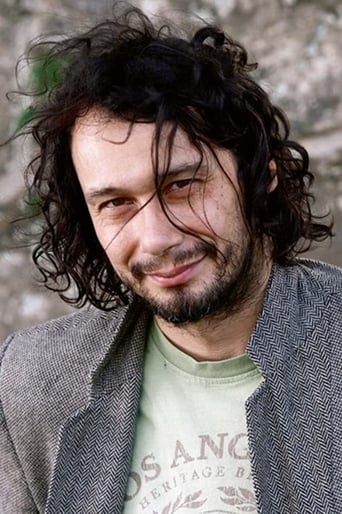SpuffyWeb
Sadly Over-hyped
ChicDragon
It's a mild crowd pleaser for people who are exhausted by blockbusters.
Sienna-Rose Mclaughlin
The movie really just wants to entertain people.
Skyler
Great movie. Not sure what people expected but I found it highly entertaining.
Leofwine_draca
Another slice of demented surrealism from the Czech king of stop motion, Jan Svankmajer. This one's not up there with CONSPIRATORS OF PLEASURE, my favourite of the director's work so far, but it contains plenty of material of interest for fans of the unique and downright bizarre.The general emphasis of the narrative is to explore the writings of the Marquis de Sade and his ilk, by exploring the treatment of the insane who are locked up in mental institutes. This typically turns out to be a study of crazy people: the inmates have literally taken over the asylum in this case, so there's lots of bizarre behaviour, blasphemy, S&M, and plenty of the outlandish sequences that anyone exposed to the director's output will expect.LUNACY is no favourite of mine, as it feels that the premise is a little dragged out and repetitive, particularly in the first half of the production. It certainly picks up for the second half, but the viewer must put up with some terrible overacting and a general lack of resolution in order to enjoy the film fully. I admit I found it all a little histrionic and difficult to sit through, although my favourite moments were the inserts featuring the stop motion 'living' meat, the bizarre highlight of an incredibly quirky film.
chaos-rampant
A lot of viewers seem to praise Svankmajer for the lunacy of his visual imagination, for the grotesque insides he's willing to lay out. I admit there is stuff worth taking from him, notions I would be interested to engage. But a lot of what he does is so blunt that I mostly want to take a step back, he can be embarrassing to watch, for example here the petulant tirade against god; what kind of god creates only in order to destroy, why doesn't he spare us the pain? Well, precisely the god, meant broadly, the universe that creates again. How selfish, how religiously salvational, exactly the thing he rants against, to think it was all going to last forever!He favors stark allegories, and this is one of the least subtle he has delivered: distinctions between tyranny and freedom as the ways to govern the world madhouse. We see one, then the other, always with an eye on the world at large, or so it goes.There is one interesting bit in all this, a clever staging; a tableaux vivant that recreates Delacroix's 'Liberty', where inmates who are ostensibly free to be as creatively mad as they want are marshaled into position as living props. During the stageshow later, one of them actually attacks in a fit of lust the woman portraying liberty. Of course unbound freedom can spawn its own despots, we're meant to take this lesson ambiguously.It's all wrapped in Poe; 'Premature Burial' as backstory attached to de Sade, a pendulum shot, the main thrust is from 'Doctor Tarr and Professor Fether'. And there is an experimental short woven through the film, typical Svankmajer stuff that he does best about animated slabs of meat trying to enter the narrative, or substituting for insights that can't be articulated there.But it's never quite as erudite as it would like to be. The final image is unremittingly blunt; modern man as another slab of meat in a long row, a prepackaged exhibit suffocating in his modern cellophane wrap. I suggest you watch instead The Hourglass Sanatorium, another Eastern European film about a damaged man mingling with madness in an effort to restore in him parts missing - the quest in both is for subconscious images of a parent. But that film unswathed in a dozen different layers, offering on the whole the purely symbolic construct of a graven image, but as a space of metaphysical contemplation on the placement of the soul in the cosmic grind. Here, it's one allegory broken out in so many authoritarian asides.
Eumenides_0
Jean Berlot is returning home after having attended his mother's funeral. She died in an asylum and Jean fears he's also developing madness too. One day he meets a mysterious Marquis who gives him a ride. This is the beginning of a journey that includes sacrilegious rites, a madhouse where the madmen have taken over, and unique methods to cure madness.This is Jan Svankmajer's horror movie and it's not only one of his best movie, it's one of the best movies of the millennium so far. In terms of stop-motion animation interaction with the real world, I'd place this on the same level as Alice and Faust. In terms of inventiveness and surreal imagery, it's also one of his strongest.Svankmajer drew inspiration from the Marquis de Sade and Edgar Allen Poe, and it shows. Horror and unreason pervade the movie. The Marquis, played by Jan Triska, is of course based on the popular perception of de Sade as a libertine who despised God and defended absolute freedom in the pursuit of excesses and pleasures. He turns a madhouse into his personal playground, manipulating the inmates into perverse games and drawing innocent to it.The scenes in the asylum are terrifying; chaos and dirt abound, naked people destroy the furniture and walk around aimlessly indulging in their weirdest pleasures. At times I was reminded of Wojciech Has' The Hourglass Sanatorium, another great surrealist movie. Poor Jean is caught in the middle of this and tries to retain his sanity as best as he can.There are many ambiguous things in the movie which will leave the viewer looking for answers that simply don't exist. There are also some amazing shots of moving meat that seem to have no relation with the main story. Just think about hunks of mean, tongues, eyes, bones, moving around as if alive. These little interludes are creepy and amusing in their own way.This is a great movie and also a parable about our times, in which the director explores two approaches to rule society: through absolute freedom, with the madmen in charge; or through punishment, with peoples's lives controlled by others who think what is best for all. It's pretty clear where Svankmajer's loyalties lie in this matter; as an artist and surrealist, he preaches absolute freedom and this is his panegyric.
Polaris_DiB
Edgar Allen Poe. The Marquis de Sade. Jan Svankmajer. If you're familiar with any of those people, and enjoy their work (or even if you don't enjoy it but you still understand what they do), then you are pretty much obligated to see this movie. If you like all those artists, then you've probably already seen it and this review is redundant.Jan Svankmajer's job in this movie is to take the theme of the lunatics running the asylum to a new extreme--hopefully to the limit, as I wouldn't want to watch what anybody would try to do further. A young man named Jean Berlot has recurring dreams of being stuck in an insane asylum, and unfortunately for him these dreams attract the attention of a mysterious Marquis who's out to help "cure" a new friend. The Marquis, however, has his own, let's call 'em, "extreme philosophies." If the storyline isn't enough, the transitions between scenes are animated with pounds of animal meat.Jan Svankmajer calls this his horror movie, and once again he shows a large amount of craftiness behind his impressions. The first two acts of the movie are so absurd they're mostly comedic, but the third act is surprisingly disturbing. You'd be surprised which characters you end up caring about and which characters you end up hating. In the end it becomes a question of how to choose your own insanity... because in a world where insanity exists sanity seems to take fifth pier.One of the more revealing parts of this movie involves its anachronism. The wooden sets are filled with timeless pieces, the gray weather can be representative or give off a feeling of a period piece, and the Marquis and Jean's journey in the coach crosses Bubonic plague-style imagery with freeways. What's more terrifying about this scene when one thinks about it later on is how even outside of the insane asylum there doesn't seem to be any sense of normalcy.Which is one of the things that is hard about this movie. Jean's delusions and his light obsessiveness makes him an untrustworthy narrator in a world where it seems like every single character harbors some maladjustment. Structurally speaking, it's unproductive to make insane characters populate an insane world without any norm for the audience to build on. For this foundation, Svankmajer seems to rely entirely on the audience, which works amazingly well. Watching this movie, for me, was even more enjoyable while hearing the laughs and moans of the people in the theatre around me. However the real drama in this film seemed to come from my own sense of values and reality desperately trying to find a handhold within the philosophies projected within the narrative. In the end the subjectivity of reality becomes more an issue of choosing one's own insanity.--PolarisDiB






